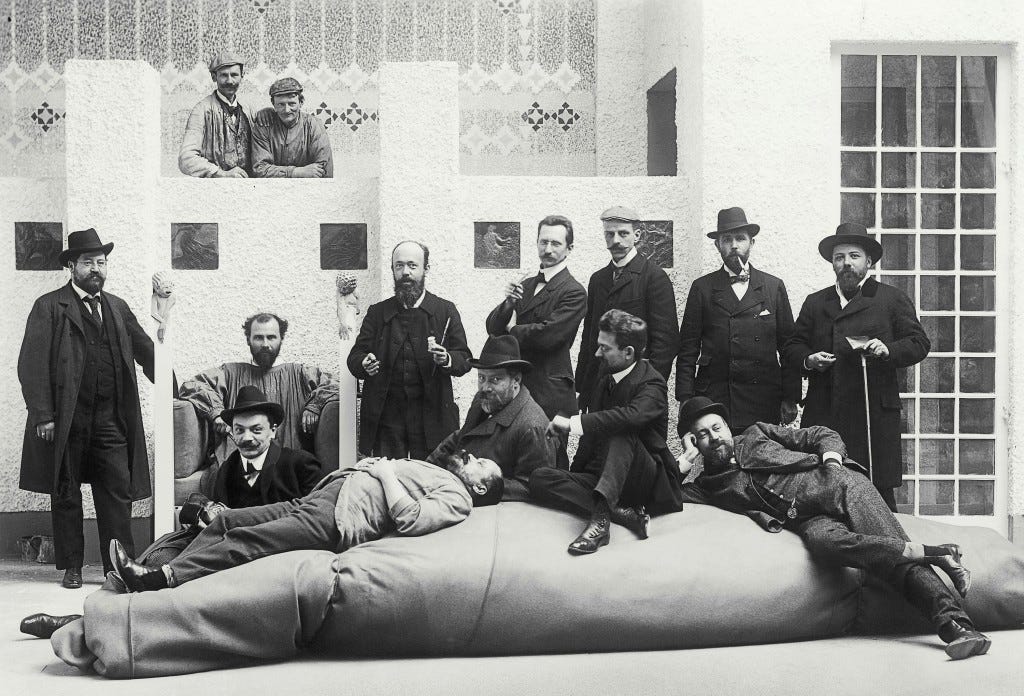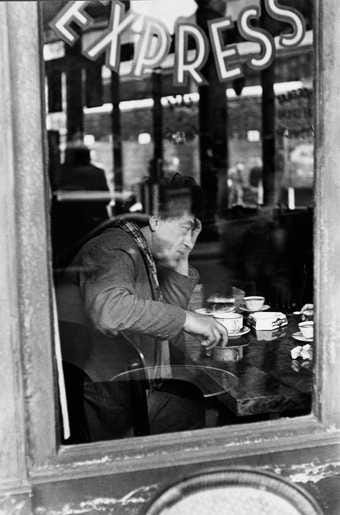Our Next Steps: Components of an Art Movement
The Exhibition in London was a first step only. Momentum demands other stages take place or the movement behind it will perish.
[The Vienna Secessionists]
Recently, a group of artists including me set up an exhibition in London. (Visit here to see it.)
However, it is very unlikely that you will see museums acquire any of our art. Although some museums have art by me, that was before I distanced myself from contemporary fine art through my criticism of feminism, the women’s art lobby, quota programming and eco-alarmism as a curatorial shibboleth.
What are the elements that comprise an art or cultural movement? Here are the components. They naturally develop sequentially.
Artists
The artists tend to come first. They do not come out of nowhere. They grow up in a culture and are trained by a system with which they have disagreements. They disagree with a culture in terms of the type of art that is appreciated, most particularly contemporary art; regarding the system, they reject the values, styles and techniques that are promoted or considered valid. As these artists grow apart from the majority of their peers, they grow closer to renegade figures and form brotherhood or associations that better reflect their taste and ambitions. They share dreams and write manifestos; they paint and draw each other; they exhibit together. Their collectors come to know the art of other artists through introductions and encountering it through publications and displays.
The artists who gather together are likely to transmit their tastes and approach and to absorb the same from their colleagues. While this does not entail that the art produced will increasingly converge and form a singularity, it is true that the movement will produce art that has greater cross-influence than otherwise. Even though it may be limited to touches, colours, motifs and so forth, the art of this movement will become more linked and consistent rather than the reverse. It will become less atomised and more co-mingled. The more the ideas, values, subjects and materials are adjacent or overlapping, the more this process is accelerated.
Collectors and audience
When a new art emerges, it will appeal to an audience. That audience may wish to take up a new fashion or return to a dormant past tradition or they may wish to follow artists who are friends or characters that they admire. Some of those viewers will wish to own that art, either to support the artists (and their values) or to acquire art that they like. Some of them will wish their names to be known and associated with the movement. Another motivation is the desire to own artefacts that display their affinities, wealth and discrimination. These motivations are not detached from material considerations, such as these artefacts will increase in value. Trading in art increases. Completists want to own collections of all prints by an artist. Others want to acquire maquettes or small versions of acclaimed pieces by sculptors. Patrons commission portraits of spouses and family members by these artists.
Gallerists
When artists who have no strong ties to existing systems, such as academies (where they do not teach), open exhibitions (which will not exhibit their art) and galleries (which will not sell their art), there is obviously an opening for mediators. One mediator is the gallerist, who can take from the artist the burden of dealing with collectors and arranging viewings and deliveries. This is a commercial opportunity for a dealer, who acts as a bridge between artist and his established collectors. However, the increase profits and broaden the collector base for the artist – imagine what would happen if the artist (and later dealer) depended solely upon one collector, who might stop buying suddenly – the dealer has to expand the number of buyers. This does not have to be an indiscriminate popularisation. Art (at the top level) is a luxury good and its cachet in part depends on exclusivity, so a gallerist does not aim to reach as many buyers, just to the best buyers and to keep the price point high and restrict supply. So, do not equate the entrance of gallerists with a movement selling out. Some artists may give in to commercial temptations and dilute their originality, style and commitment to core values, but also consider the influence other way. Viewed in terms of elite theory, we are more likely to see the artists and their allies alter the market towards their values.
Critics
Part of the apparatus of a new movement is the appearance of critics, who take trouble to learn about the movement and explain its principles, personnel and values. They then discern between the levels of seriousness and accomplishment of the participants in the movement. They write reviews, profiles and conduct interviews. They are invited to write catalogue essays, then artist monographs or biographies. These critics are sometimes already established when the movement begins. Others are more closely bound to the movement and can be minor artists with a talent for writing (and suitable connections to get that writing read). These latter critics are more advocates than anything else and they see their success as tied to the prestige of the movement. They work naturally to make the movement more coherent, more vanguard, more important than perhaps it warrants, because the importance of the movement means that its arbiters-cum-experts are commensurately more powerful.
[Alberto Giacometti in Paris, 1950s]
Salons
The need to associate and co-ordinate leads to socialisation. In the past the cafés, bars and restaurants were meeting places for artists, models, critics and collectors; eventually, these places became so well know for this reason that fans travelled to hang out there and meet their heroes. To a degree we now have virtual salons – the Discord chat room and the chat function and comment section of the livestream. We recognise characters, public figures drop in, debates rage and jokes are made. However, the importance of meeting in real life is great. Forming human connections is easier and the consequential ties are deeper when we meet in life. The difficulty is that movements in the past were generally based on geography. The Schools of Barcelona, Delft, Paris, New York, London, St Ives and untold others consisted of artists who (at least for a time) lived within walking distance of each other. Some of these semi-public spaces became venues where are art was exhibited or donated by the habitués. El Quatre Gats and La Lapin agile hosted the became the first public displays of new art. Before the galleries of the Paris Right Bank or the museums of the New York Upper East Side were conquered, the coffee houses and cafeterias were decorated by the art of new movements.
Of course, members of a movement generally just prefer to go to certain establishments. They don’t set up their own cafés specifically to serve them and their friends. Over time, these places may become reliant on such patronage but most establishments survive the demise of their movements (and vice versa). They are not essential, because artists and their circles often meet in homes or attend public events together. There was the tradition of the literary salons held by hosts (or more often by hostesses) who would invite luminaries and this was a way they became acquaintances and how younger figures were introduced to the great creators. These were a development of the upper-class “at-home”, when one set afternoon once per week a person opened their sitting room to allow visitors to call in person. It is a shame that such personal contact is more difficult because of the geographical distribution of new art movements. For example, in our movement, artists live in the USA, Belgium, Montenegro and various parts of England. Despite putting on our show, we have never all met at the same time and some members have never met each other.
Publishing
Publication of catalogues, books, newsletters and manifestos accompany every art movement. Much of this is done via self-publishing because the established channels do not see the value of this material, that is when they do not actively disapprove of it. Self-publishing is now a lot easier due to print-on-demand services and online selling. Nonetheless, even today people who specialise in printing and selling this material are of great benefit to artists, who are not best suited for the manufacture and distribution of printed matter. There are many opportunities for publishing houses and distributors (in our case, primarily IM-1776, Man’s World, Bournbrook Press, The Jackdaw and The Mallard) for those who run a business of publishing. As our movement grows, so demand for written material and reproductions grow. There is no need for the artists themselves to do this work because it is best handled by others who can give it their expertise and time.
These are the initial stages for the first few years of a movement. The role of historians and museums is a matter for the later period, when these first stages are long established. These are stages that arise usually without explicit guidance from the artists involved. They come about because the logic of a movement and the economic and social imperatives that govern human interaction compel them. Watch for these stages, because these will soon arise with our own art movement. If they do not, there will be no movement because movement implies momentum and power. It is the power of money and prestige that will cause collectors to emerge, gallerists take on selling opportunities, critics to write and publishers to disseminate information.
We thrive or the movement dies. There is no halfway position.



I think so. I will report in full in October.
I’ve just read this article in hard copy at Bournbrook Magazine and just bought a piece of your art via Imperium Press. I opted for Carlyle. We love it and will have it framed soon.
Congratulations in launching your new venture.